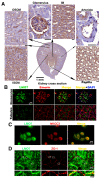Coordination of LMO7 with FAK Signaling Sustains Epithelial Integrity in Renal Epithelia Exposed to Osmotic Pressure
- PMID: 36497072
- PMCID: PMC9741450
- DOI: 10.3390/cells11233805
Coordination of LMO7 with FAK Signaling Sustains Epithelial Integrity in Renal Epithelia Exposed to Osmotic Pressure
Abstract
The kidney epithelial barrier has multifaceted functions in body fluids, electrolyte homeostasis, and urine production. The renal epithelial barrier (REB) frequently faces and challenges osmotic dynamics, which gives rise to osmotic pressure (a physical force). Osmotic pressure overloading can crack epithelial integrity and damage the REB. The endurance of REB to osmotic pressure forces remains obscure. LMO7 (LIM domain only 7) is a protein associated with the cell-cell junctional complex and cortical F-actin. Its upregulation was observed in cells cultured under hypertonic conditions. LMO7 is predominantly distributed in renal tubule epithelial cells. Hypertonic stimulation leads to LMO7 and F-actin assembly in the cortical stress fibers of renal epithelial cells. Hypertonic-isotonic alternation, as a pressure force pushing the plasma membrane inward/outward, was set as osmotic disturbance and was applied to test FAK signaling and LMO7 functioning in maintaining junctional integrity. LMO7 depletion in cells resulted in junctional integrity loss in the epithelial sheet-cultured hypertonic medium or hypertonic-isotonic alternation. Conversely, FAK inhibition by PF-573228 led to failure in robust cortical F-actin assembly and LMO7 association with cortical F-actin in epithelial cells responding to hypertonic stress. Epithelial integrity against osmotic stress and LMO7 and FAK signaling are involved in assembling robust cortical F-actin and maintaining junctional integrity. LMO7 elaborately manages FAK activation in renal epithelial cells, which was demonstrated excessive FAK activation present in LMO7 depleted NRK-52E cells and epithelial integrity loss when cells with LMO7 depletion were exposed to a hypertonic environment. Our data suggests that LMO7 regulates FAK activation and is responsible for maintaining REB under osmotic disturbance.
Keywords: FAK hypertonicity; LMO7; cortical stress fiber; epithelial barrier; epithelial integrity; osmotic stress; secretome.
Conflict of interest statement
All authors declare that they have no competing financial interest, such as consultancies, stock ownership or other equity interests or patent-licensing arrangements.
Figures







Similar articles
-
LMO7 mediates cell-specific activation of the Rho-myocardin-related transcription factor-serum response factor pathway and plays an important role in breast cancer cell migration.Mol Cell Biol. 2011 Aug;31(16):3223-40. doi: 10.1128/MCB.01365-10. Epub 2011 Jun 13. Mol Cell Biol. 2011. PMID: 21670154 Free PMC article.
-
LMO7 exerts an effect on mitosis progression and the spindle assembly checkpoint.Int J Biochem Cell Biol. 2018 Jan;94:22-30. doi: 10.1016/j.biocel.2017.11.006. Epub 2017 Nov 20. Int J Biochem Cell Biol. 2018. PMID: 29158164
-
Hypertonic inhibition of exocytosis in neutrophils: central role for osmotic actin skeleton remodeling.Am J Physiol Cell Physiol. 2000 Sep;279(3):C619-33. doi: 10.1152/ajpcell.2000.279.3.C619. Am J Physiol Cell Physiol. 2000. PMID: 10942712
-
Actin dynamics at focal adhesions: a common endpoint and putative therapeutic target for proteinuric kidney diseases.Kidney Int. 2018 Jun;93(6):1298-1307. doi: 10.1016/j.kint.2017.12.028. Epub 2018 Apr 17. Kidney Int. 2018. PMID: 29678354 Free PMC article. Review.
-
RhoGTPases, actomyosin signaling and regulation of the epithelial Apical Junctional Complex.Semin Cell Dev Biol. 2014 Dec;36:194-203. doi: 10.1016/j.semcdb.2014.09.003. Epub 2014 Sep 16. Semin Cell Dev Biol. 2014. PMID: 25223584 Free PMC article. Review.
Cited by
-
Comprehensive analysis Neddylation-related genes identified UBB as a prognostic biomarker for clear cell renal cell carcinoma.Discov Oncol. 2025 May 22;16(1):859. doi: 10.1007/s12672-025-02547-7. Discov Oncol. 2025. PMID: 40402349 Free PMC article.
-
Permanent defects in renal medullary structure and function after reversal of urinary obstruction.JCI Insight. 2025 Jan 23;10(5):e187008. doi: 10.1172/jci.insight.187008. JCI Insight. 2025. PMID: 39847447 Free PMC article.
References
-
- Hara M., Minami Y., Ohashi M., Tsuchiya Y., Kusaba T., Tamagaki K., Koike N., Umemura Y., Inokawa H., Yagita K. Robust circadian clock oscillation and osmotic rhythms in inner medulla reflecting cortico-medullary osmotic gradient rhythm in rodent kidney. Sci. Rep. 2017;7:7306. doi: 10.1038/s41598-017-07767-8. - DOI - PMC - PubMed
-
- Roffay C., Molinard G., Kim K., Urbanska M., Andrade V., Barbarasa V., Nowak P., Mercier V., Garcia-Calvo J., Matile S., et al. Passive coupling of membrane tension and cell volume during active response of cells to osmosis. Proc. Natl. Acad. Sci. USA. 2021;118:e2103228118. doi: 10.1073/pnas.2103228118. - DOI - PMC - PubMed
MeSH terms
Substances
LinkOut - more resources
Full Text Sources
Miscellaneous

